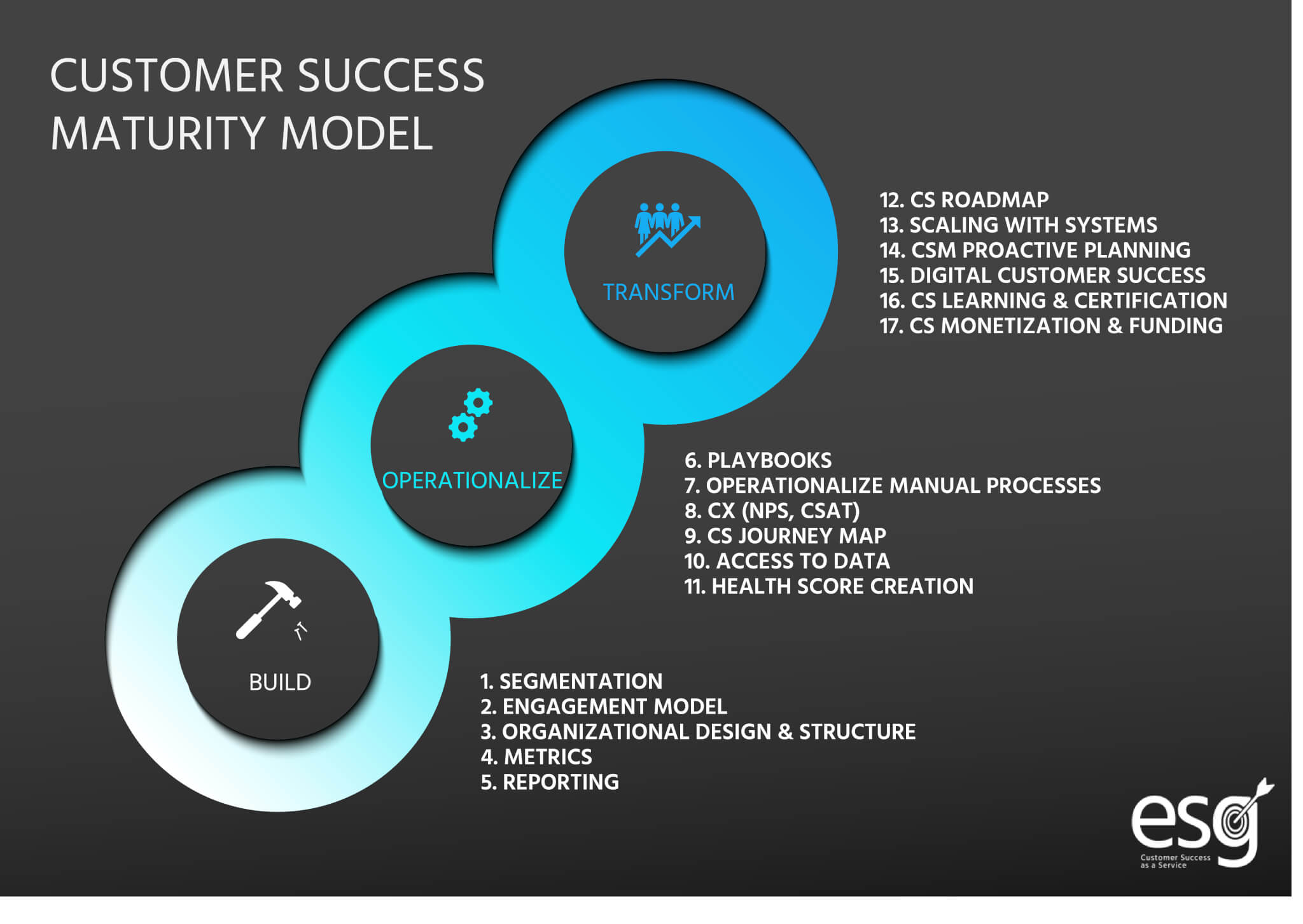Building a Customer Success Organization is no easy task. Let me rephrase. Building a proactive and predictive CS organization is no easy task. Make no mistake, there is big difference between adding CS to a company org chart vs. building a scalable operationalized practice.
To accomplish this, here are just a few considerations to keep in mind. You’ll need to define, hire, train, and retain a spectrum of CS roles (not just CSMs). Dozens of processes and capabilities will need to be developed, along with a healthy stack of tools and technology deployed. You’ll need executive buy-in to a long-term strategy. The average time to scale a CS organization exceeds three years, so setting the right expectations early on is critical. Because CS does not operate in a silo, you’ll need the support of cross-functional leaders to ensure systematic success. And last, if you think customer adoption is tough, try changing the way your company operates without a strong change management process in place to ensure that all internal stakeholders are adopting the new and improved operating model.
Clearly, this task is not for the weak of heart. But successfully navigating these waters will pay dividends on the other side. Improved share price, market value, revenue growth, operating income, and job security to name just a few. But how can one manage through all the complexity mentioned above? The short answer: with difficulty. Not where you thought I was going with that, huh? But all is not lost, I promise. ESG has created a proven way to make this daunting task much easier, with the ESG Customer Success Maturity Model. Before I dive into the specifics, let’s discuss how this framework can benefit you immediately:
- Structure and Organization: Work smart, not hard. You and your team are investing the hours, but you’re not moving quite as fast as you’d like, or your executives are expecting. The ESG Customer Success Maturity Model will bring a layer of structure and organization to keep your program on the rails and moving forward.
- Performance Benchmarking: You’re working smart and hard but finding time to connect with other CS leaders to evaluate how you compare to companies like you is difficult. Our benchmark data can help you understand if you are ahead or behind the curve, which is a valuable data point for many executives.
- Maturity Velocity: With plenty to do, and often limited resources available to accomplish said tasks, where should your limited available time and energy be allocated for the biggest impact? Prescriptively understanding your gaps and building a plan based on these findings will significantly increase the speed of your maturation.
- Measuring Early Progress: The work you do early on in developing capabilities will often not lead to an immediate impact on lagging indicators like renewal rate and expansion. You’ll need interim data points to illustrate progress. An output of the ESG Customer Success Maturity Model is an objective score that can be used to maintain trust with your executive team to demonstrate that you’re moving in the right direction.
The ESG Customer Success Maturity Model is a framework we’ve built over the past three years, aggregating findings from interviews with 100+ CS leaders, our learnings from best-in-class CS research firms like TSIA, and the participation of dozens of CS friends, consultants, and our customers – some of whom represent the most mature CS orgs in the world.
We’ve collectively identified 17 key capabilities mapped across three categories: what are the capabilities required to 1. Build a CS practice, then 2. Operationalize CS, and last 3. Transform this critical function of your business in order to scale.

Each capability is then assigned a weighted score. Let’s use Customer Experience as an example. Here’s something I hear a lot: “yes I do this, I’m sending out an NPS survey, and that score is good, therefore I have a developed CX capability.” Hmm, perhaps. When going through this Maturity Model, we care less about checking a box and more about how you’re thinking about and doing that thing. Here’s what I mean: what other CX metrics are you tracking? How often are you collecting data? Are you tracking operational metrics like participation rate? If so, what are you doing to increase your participation rate? Do you understand what leads to a high or low NPS? What happens when a negative score is received? What do you do with customer feedback? How do you close the loop? Can you tie these actions to advocacy behavior?
The answers to these questions will net you a weighted score demonstrating your progression (low, medium, high) of each specific capability. Now take this same methodology and apply it to each of the 17 capabilities. Through that process, the ESG Customer Success Maturity Model maps over 130 data points, giving you a granular view into organizational performance and enriched insights into the bottlenecks hindering your business performance today.
Whether you’re just beginning your CS journey or have already established the fundamentals but are looking for what’s next, this model was built to help you take those steps. I’d encourage you to leverage our nearly two decades and thousands of hours of experience in Customer Success that went into building this model as an effective and proven tool to accelerate your time to market, shortening the road between you and a truly proactive and predictive CS organization.

